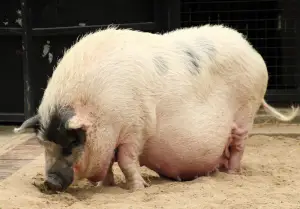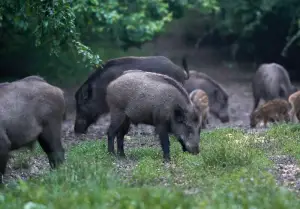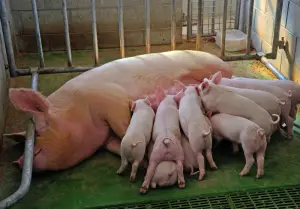What Is Farrowing In Pigs?
If you’re new to pigs, there may be several terms that are foreign to you. Have you heard (and been confused by) the term “farrowing”? This is a term specific to the swine industry, and is not used for other livestock.
What does “farrowing” mean? To “farrow” simply means to birth a litter of piglets. This term is most often used as a verb (i.e. “the sow is due to farrow the second week of June”), but may also be used as a noun to refer to a litter of piglets (i.e. “there were eleven piglets in the farrow”).
Pigs are prolific breeders, and it is worth understanding the farrowing process if you are breeding pigs. Read on to learn more about farrowing and pig gestation.
Pig Farrowing Timeline 
One of the reasons that pigs are such prolific breeders is because of their relatively short heat cycles and gestation periods.
Most domesticated breeds will be fertile year round and able to produce two litters per year. The heat cycle of gilts (female pigs who has never produced a litter) and sows (female pigs who have farrowed at least once) lasts an average of 21 days. This means that if a pig is not successfully bred, one must only wait about 21 days to try again.
While many gilts reach sexual maturity between 5 and 6 months of age, they should not be introduced to a boar until they have reached their second or third heat. Gilts successfully bred during their first cycle can have lasting fertility problems including smaller litters and shorter breeding lifespans.
The gestation length of a pig is easy to remember – pregnancy lasts around 3 months, 3 weeks, and 3 days (or about 115 days). Most professionals advise sows be kept isolated for 2-4 weeks post breeding, as moving them during these early weeks can cause stress-related miscarriage. After this time, most sows can continue to cohabitate safely until the last stages of pregnancy, when the sow should be moved to a farrowing pen or otherwise isolated.
Average Number Of Piglets In A Farrow
The other reason that pigs are such productive breeders is related to the number of piglets farrowed in each litter. Average litter size will vary among breeds, but most domestic breeds will farrow at least 8-10 piglets at a time, with some breeds commonly farrowing 15 or more piglets per litter. The Meishan takes the cake when it comes to litter size, averaging 15-20 piglets at a time.
While feral and wild pigs also have relatively large litters, today’s litter sizes have, for the most part, been bred into domestic pigs. Pigs are bred mainly for meat production, and more piglet production equals more meat production. Feral hogs have an average litter size of around 4-6 piglets per farrow, though anywhere between 1 and 12 piglets is within the range of normal.
Pre-Farrowing Guidance For Domestic Pigs
Sows typically make excellent mothers, and will know what to do instinctively as their time to farrow approaches. Nevertheless, there are a few considerations that should be taken in a domestic setting.
Farrowing Pens
It is advised that sows be separated from the rest of the herd 1-2 weeks prior to their anticipated farrowing date, and moved into a disinfected farrowing pen or shelter. In the shelter should be ample clean bedding in the form of shavings or short straw so that the sow can create a nest. It should also be protected from the chill, as newborn piglets can easily succumb to the elements if not kept warm.
One addition that has been proven to decrease piglet mortality numbers is a heat lamp. It is recommended that a heat lamp be safely added to the shelter as farrowing becomes imminent. Research has shown that adding a heat lamp above the area of the sow’s rump provides a boost to the piglets as they are delivered.
Pre-Farrow Immunizations And Deworming
It is almost universally advised that domestic sows be immunized (or boosted) and de-wormed prior to farrowing. The vaccine boost will allow the antibodies to more effectively transfer to the piglets, and the de-worming will prevent the piglets from being infested with parasites.
Common parasites that can quickly overwhelm the immature immune system of a piglet are large roundworms and thread worms (Strongyloids). These parasites are not usually problematic to a mature pig but can become dangerous when passed to a young piglet. The most commonly used dewormers to protect against these parasites are fenbendazole and ivermectin.
Farrowing In The Wild 
Farrowing among feral pig populations will understandably look different than farrowing in the domesticated population. Feral sows will begin to isolate themselves from the group 24-48 hours prior to farrowing in search of a good birthing location, often times ending up as much as 1.5-4 miles away from the herd. Sows will search for a tucked away and well-hidden site on a slope if available.
After locating the right spot, sows will root and build their nests. A sow will use her nose to create a 2-4” depression in the ground, in which she will fill with plant matter and twigs. Once she feels labor approaching, she will settle onto her side, where she will stay for the next 48 hours as her piglets settle in and nurse from her.
For the next 1-2 weeks, the sow will stay in her nesting area with her piglets, after which time the group will venture closer and closer to the herd until they have been re-integrated. This will be a gradual process, with the sow often “introducing” her piglets to the herd in short periods of time before fully moving back in.
Do Pigs Require Help With Farrowing?
Pigs are naturally hardy breeders and do not often need human intervention while farrowing. In fact, it is not uncommon for a pig farmer to be surprised in the morning by the sight of a litter of healthy, happy piglets. However, there are situations in which a sow will require human assistance.
Labor for a sow should only last around 2-3 hours from start to finish, with most piglets delivered in 15-20 minute intervals. It is not uncommon for the interval between the first and second piglet to be somewhat longer. The most strain on the sow’s part will occur with the delivery of the first piglet, with decreased strain typically seen with successive piglets. While most sows do not need help, it is advised that farrowing is supervised (from a distance, unless your sow is especially docile) so that assistance can be provided if needed.
Just prior to delivering a piglet, the sow will often shudder or shiver, while lifting her upper hind leg and twitching her tail. If it has been more than 30-45 minutes and the shivering has stopped, chances are high that the sow has delivered her last piglet. Within about 4 hours of the last delivery the placenta will deliver, though sometimes it will pass in pieces with each piglet. If you are present when the placenta is delivered at the end, visually assess to ensure that there is not a piglet trapped within.
Providing Assistance To A Farrowing Sow
If there are still piglets to be delivered and it has been 30-45 minutes with no activity, the sow should be assessed by a veterinarian, an experienced pig farmer, or you. Before assessing, ensure that the vulva is clean and disinfected, to decrease the chances of introducing any harmful pathogens into the sow’s body.
Glove or otherwise wrap your hand up to the elbow, pinch your thumb and fingers together, and try to insert your hand into the sow’s vaginal canal. If you feel a piglet, gently grab hold and pull toward you – you can “pinch” the piglet’s neck with your forefinger and middle finger if the piglet is presenting head-first, or you can grasp two legs together above the knees or hocks if presenting feet-first (just make sure that the two legs belong to one piglet!).
Most of the early piglets present head-first, with other presentations increasing in frequency toward the end of the litter. If you are at all unsure on how to proceed, call in the experts.
If you have reached into the sow and you cannot feel the presence of a piglet, but she is in obvious discomfort and there has not yet been an expunged placenta, you will need to call a veterinarian right away. Failure to progress with farrowing is most commonly the result of either a lack of uterine contractions or an obstruction of the birth canal.
A lack of uterine contractions is more commonly seen with older and/or heavier sows. A birth canal obstruction is often the result of an exceptionally large piglet, a sideways presentation, or two piglets attempting to exit the birth canal simultaneously.
Difficult Farrowings Are Uncommon
You may go through your entire (small-scale) pig farming career without ever having to intervene in a farrowing. Pigs are hardy, maternal animals bred in part for their farrowing and mothering abilities. Nevertheless, it is always best to arm yourself with ample knowledge before embarking on a breeding program.

